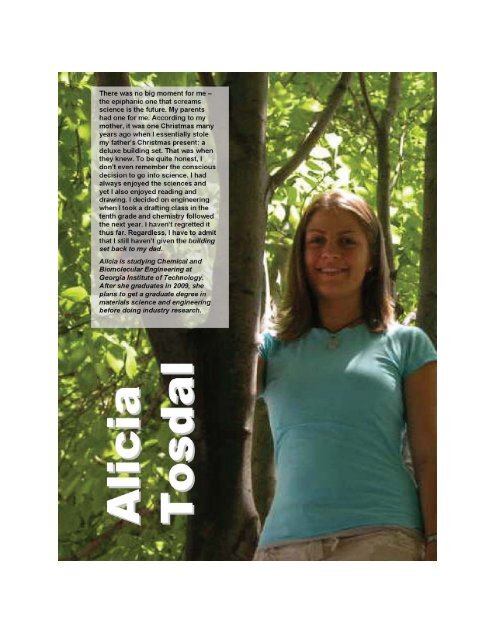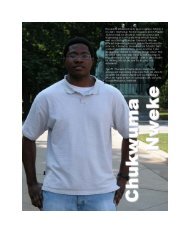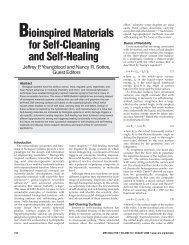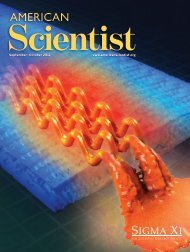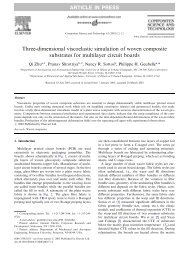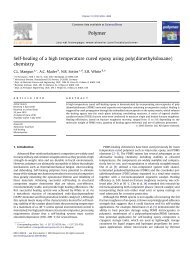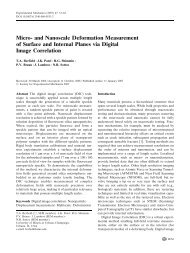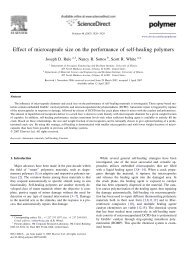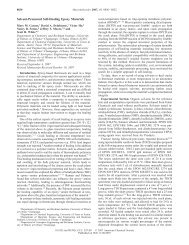Alicia Tosdal - Sottos Research Group - University of Illinois at ...
Alicia Tosdal - Sottos Research Group - University of Illinois at ...
Alicia Tosdal - Sottos Research Group - University of Illinois at ...
Create successful ePaper yourself
Turn your PDF publications into a flip-book with our unique Google optimized e-Paper software.
Center for Nanoscale Chemical-Electrical-Mechanical Manufacturing Systems<br />
Directed Printing <strong>of</strong> Self-Healing<br />
Capsules through Dielectrophoretic<br />
Force<br />
Undergradu<strong>at</strong>e <strong>Research</strong>er<br />
<strong>Alicia</strong> <strong>Tosdal</strong>, <strong>Research</strong><br />
Experience for Undergradu<strong>at</strong>es<br />
(REU), Georgia Institute <strong>of</strong><br />
Technology<br />
Faculty Mentor<br />
Pr<strong>of</strong>essor Nancy R. <strong>Sottos</strong>,<br />
Department <strong>of</strong> Mechanical<br />
Science and Engineering,<br />
<strong>University</strong> <strong>of</strong> <strong>Illinois</strong> <strong>at</strong> Urbana-<br />
Champaign<br />
Gradu<strong>at</strong>e Student Mentor<br />
Jinglei Yang, Beckman Institute<br />
for Advanced Science and<br />
Technology, <strong>University</strong> <strong>of</strong><br />
<strong>Illinois</strong> <strong>at</strong> Urbana-Champaign<br />
Abstract<br />
Dielectrophoretic force applied<br />
by a non-uniform electric field<br />
over the sample manipul<strong>at</strong>es<br />
self-healing capsules into a<br />
distinct monolayer. Suspended<br />
in distilled w<strong>at</strong>er with controlled<br />
pH levels, long chains form. The<br />
chains form on the lowest level,<br />
spanning the shortest distance<br />
between the two electrodes.<br />
Capsule concentr<strong>at</strong>ion by weight<br />
<strong>of</strong> less than 2wt% has been<br />
shown to produce chains<br />
spanning the electrodes under an<br />
altern<strong>at</strong>ing field <strong>of</strong> 75V/cm with<br />
a frequency <strong>of</strong> 5kHz. Averaging<br />
2.1μm, the chains cure in<br />
proportion to the diameter <strong>of</strong> the<br />
various capsules in the chain.<br />
When suspended in polymer,<br />
dispersion is difficult due to the<br />
increased viscosity. The<br />
nanocapsules form large<br />
aggreg<strong>at</strong>es instead <strong>of</strong> dispersing<br />
as individual capsules. The<br />
capsules chain within the<br />
aggreg<strong>at</strong>es as a result.<br />
Introduction and<br />
Background<br />
Self-healing with<br />
dicyclopentadiene (hereafter<br />
DCPD) occurs via ring-opening<br />
met<strong>at</strong>hesis, a chemical reaction<br />
th<strong>at</strong> allows mass polymeriz<strong>at</strong>ion<br />
in the presences <strong>of</strong> a c<strong>at</strong>alyst.<br />
DCPD, encapsul<strong>at</strong>ed with poly<br />
(urea-formaldehyde) by in situ<br />
oil-in-w<strong>at</strong>er-emulsion reactions,<br />
is an organic monomer with two<br />
different conform<strong>at</strong>ional<br />
isomers. Exo-DCPD is the more<br />
reactive <strong>of</strong> the two isomers, but<br />
endo-DCPD is altern<strong>at</strong>ively<br />
more stable. Likewise, while the<br />
exo isomer makes non-uniform<br />
shell walls, the endo isomer<br />
gener<strong>at</strong>es more uniform shell<br />
wall thickness. Because <strong>of</strong> the<br />
instability <strong>of</strong> the exo-DCPD, the<br />
resulting capsule shells form<br />
irregular spheres. As seen in<br />
Figure 1, the shell wall is nonuniform<br />
in shape and <strong>of</strong>ten has<br />
irregularities in thickness,<br />
causing leakage. While the exo<br />
isomer is more reactive, it exists<br />
in significantly smaller<br />
quantities than endo-DCPD. As<br />
a result, use <strong>of</strong> the endo isomer<br />
is more prevalent. The<br />
encapsul<strong>at</strong>ed microcapsules <strong>of</strong><br />
DCPD are suspended in an<br />
epoxy m<strong>at</strong>rix with the c<strong>at</strong>alyst.<br />
The c<strong>at</strong>alyst used for the<br />
reaction is Grubb’s c<strong>at</strong>alyst. In<br />
the case th<strong>at</strong> the epoxy m<strong>at</strong>rix is<br />
cracked, the crack may breach<br />
the shell <strong>of</strong> a capsule. As the<br />
crack propag<strong>at</strong>es through the<br />
epoxy, the dicyclopentadiene<br />
leaks from the cracked shell and<br />
reacts upon contact with the<br />
Grubb’s c<strong>at</strong>alyst. This reaction<br />
fills the crack gener<strong>at</strong>ed in the<br />
epoxy m<strong>at</strong>rix and promotes selfhealing.<br />
1<br />
When the capsules are<br />
suspended in the epoxy m<strong>at</strong>rix,<br />
they are rarely suspended<br />
uniformly. This non-uniform<br />
dispersion leads to unequal<br />
healing in the event th<strong>at</strong> cracks<br />
appear under stress. Capsules<br />
<strong>of</strong>ten appear as aggreg<strong>at</strong>es in the<br />
epoxy. When studied under an<br />
electric field, silica particles<br />
with a diameter <strong>of</strong> 1μm have<br />
been found to form a uniform<br />
monolayer. 2 This monolayer is<br />
formed through<br />
dielectrophoresis (DEP), more<br />
specifically dielectrophoretic<br />
force. DEP force is a force<br />
exerted specifically on a<br />
dielectric particle when it is<br />
subjected to a non-uniform<br />
electric field. DEP force does<br />
not require the particle to be<br />
charged. In the case <strong>of</strong> the<br />
encapsul<strong>at</strong>ed DCPD, the<br />
microcapsules carry a net<br />
neutral charge. Under the nonuniform<br />
field, however, the<br />
capsules undergo a net dipole<br />
moment. The dipole moment<br />
causes one side <strong>of</strong> the capsule to<br />
gain a positive charge facing the
neg<strong>at</strong>ive electrode. The other<br />
side <strong>of</strong> the capsule carries a net<br />
neg<strong>at</strong>ive charge equal in<br />
magnitude but opposite in<br />
charge to the positive side.<br />
Because the two sides <strong>of</strong> the<br />
capsule have opposing charges,<br />
the microcapsule still has a net<br />
neutral charge once the field is<br />
gone. The capsule, once<br />
charged, <strong>at</strong>tracts the oppositely<br />
charged side <strong>of</strong> the next closest<br />
capsule, thus lining up according<br />
to electric field lines. 3-5 The size<br />
<strong>of</strong> the dipole moment, sign and<br />
magnitude, can be determined<br />
through the Clausius-Mossotti<br />
function. 6,7<br />
* *<br />
ε<br />
p<br />
− ε<br />
m<br />
K(<br />
ω)<br />
= where<br />
* *<br />
ε + 2ε<br />
*<br />
ε = ε −<br />
p<br />
jσ<br />
ω<br />
Where ω is the angular<br />
frequency <strong>of</strong> the applied field, σ<br />
is the conductivity, ε p and ε m are<br />
the dielectric constants <strong>of</strong> the<br />
particles and the media<br />
respectively.<br />
m<br />
Figure 1: ESEM photograph <strong>of</strong> exo-<br />
DCPD nanocapsules averaging<br />
2.1μm in diameter. The deformed<br />
poly(urea-formaldehyde) shell walls<br />
demonstr<strong>at</strong>e the non-uniformity<br />
present with the exo isomer.<br />
The average size <strong>of</strong> capsules is<br />
2.1 μm in diameter with a<br />
standard devi<strong>at</strong>ion <strong>of</strong> 1.15μm.<br />
The mode produced is a<br />
diameter size <strong>of</strong> 1.5 μm. The<br />
overall range <strong>of</strong> microcapsule<br />
size runs from approxim<strong>at</strong>ely<br />
300nm to 10 μm. This is a result<br />
<strong>of</strong> the oil-in w<strong>at</strong>er emulsion used<br />
to cre<strong>at</strong>e the DCPD<br />
microcapsules. Because <strong>of</strong> the<br />
irregularity in sizing, the<br />
dielectrophoretic assembly <strong>of</strong><br />
the capsules into lines is<br />
increasingly difficult, more so<br />
than uniformly sized silica<br />
capsules. The emulsific<strong>at</strong>ion<br />
process used to make the<br />
microcapsules does not exhibit<br />
gre<strong>at</strong> control over the resulting<br />
sizes <strong>of</strong> capsule produced. The<br />
range <strong>of</strong> capsule sizes produced<br />
can be seen in Figure 2.<br />
The smaller the average size <strong>of</strong><br />
the capsules in the electric field,<br />
the more sensitive the capsules<br />
are to field strength and<br />
distribution. Larger<br />
microcapsules react more slowly<br />
to lower field strengths than<br />
smaller capsules will. Because<br />
the capsules are smaller, a<br />
reduced amount <strong>of</strong> force will<br />
move the capsule the same<br />
manner as the larger capsule.<br />
Likewise, the amount <strong>of</strong> DEP<br />
force required also depends<br />
upon m<strong>at</strong>erials used in synthesis<br />
as well as the medium. More<br />
polarizable shell m<strong>at</strong>erial will<br />
undergo dielectrophoresis more<br />
easily than nonpolar shell<br />
m<strong>at</strong>erials. Likewise, the medium<br />
the capsules are suspended in is<br />
also subject to field strengths<br />
and vari<strong>at</strong>ions. When suspended<br />
in distilled w<strong>at</strong>er, if the electric<br />
field strength becomes too high<br />
w<strong>at</strong>er undergoes electrolysis,<br />
cre<strong>at</strong>ing an air pocket inside the<br />
suspension.
Center for Nanoscale Chemical-Electrical-Mechanical Manufacturing Systems<br />
Figure 2: NiComp 388 distribution <strong>of</strong> capsule size. Microcapsules were measured as vesicles r<strong>at</strong>her than solid particles. The mean<br />
distribution shown above is 2118.4nm, or 2.1184μm. The standard devi<strong>at</strong>ion for size analysis is 1152.4nm. The vertical axis<br />
describes the rel<strong>at</strong>ive quantity <strong>of</strong> each size range while the horizontal axis describes the approxim<strong>at</strong>e diameter <strong>of</strong> the capsule. Most<br />
microcapsules range from approxim<strong>at</strong>ely 1.5μm to 2.1μm. The coefficient <strong>of</strong> vari<strong>at</strong>ion for this sample is 0.544.<br />
Approach<br />
M<strong>at</strong>erials<br />
DCPD microcapsules were<br />
suspended in distilled, deionized<br />
w<strong>at</strong>er and then placed upon a<br />
gap in between two planar<br />
vapor-deposited gold electrodes.<br />
The altern<strong>at</strong>ing, non-uniform<br />
field came from a function<br />
gener<strong>at</strong>or hooked in parallel to<br />
an amplifier. A voltmeter is<br />
likewise added in parallel in<br />
order to monitor field strength<br />
across the suspension sample.<br />
The various concentr<strong>at</strong>ions <strong>of</strong><br />
separ<strong>at</strong>e samples are recorded<br />
by Thermogravimetric Analysis<br />
(TGA). He<strong>at</strong> is ramped from<br />
25 °C <strong>at</strong> a r<strong>at</strong>e <strong>of</strong> 10 °C/min<br />
until 600 °C. The boiling point<br />
<strong>of</strong> w<strong>at</strong>er is 100 °C and DCPD<br />
microcapsules boil <strong>of</strong>f <strong>at</strong><br />
approxim<strong>at</strong>ely 250 °C. The<br />
approxim<strong>at</strong>e concentr<strong>at</strong>ion <strong>of</strong><br />
microcapsules can be recorded<br />
by the pl<strong>at</strong>eau between 100 °C<br />
and 200 °C. See Figure 6.<br />
Prepar<strong>at</strong>ion<br />
DCPD microcapsules were<br />
cre<strong>at</strong>ed by encapsul<strong>at</strong>ing DCPD<br />
monomer (15.5% w/v) in an in<br />
situ emulsific<strong>at</strong>ion process with<br />
polymeriz<strong>at</strong>ion <strong>of</strong> urea and<br />
formaldehyde. 8 The surfactant<br />
solution consists <strong>of</strong> equal<br />
volumes deionized w<strong>at</strong>er and<br />
ethylene-maleic anhydride<br />
copolymer (Zemac-400 EMA,<br />
ammonium chloride, resorcinol,<br />
and urea. The DCPD is added<br />
slowly to begin the<br />
emulsific<strong>at</strong>ion before being<br />
allowed to equilibr<strong>at</strong>e. The<br />
entire process takes place under<br />
stirring conditions <strong>of</strong><br />
approxim<strong>at</strong>ely 800 RPM.<br />
Sonic<strong>at</strong>ion by a 750-W<strong>at</strong>t<br />
ultrasonic homogenizer (Cole-<br />
Parmer®) takes place after<br />
solution has reached st<strong>at</strong>ic<br />
conditions for approxim<strong>at</strong>ely<br />
1.5 min. The sonic<strong>at</strong>ion horn tip,<br />
1/8″ across, is placed in the<br />
beaker next to the mixer blade<br />
without touching the beaker or<br />
the blade. The sonic<strong>at</strong>or is<br />
turned on for the dur<strong>at</strong>ion <strong>at</strong><br />
40%. Formalin (37%<br />
formaldehyde) is added in a<br />
r<strong>at</strong>io described by Brown et al. 1<br />
Once the formalin is added to<br />
the emulsific<strong>at</strong>ion, it is left to<br />
react for four hours under<br />
constant mixing conditions. The<br />
capsules are then left to sit<br />
overnight while the shells set<br />
once emulsific<strong>at</strong>ion has finished.<br />
The microcapsules are cleaned<br />
through centrifuging in a<br />
mixture <strong>of</strong> methanol and<br />
undistilled DCPD. The solution<br />
is approxim<strong>at</strong>ely equal volume<br />
methanol and DCPD. The IEC<br />
Multi® Centrifuge (Thermo<br />
Electron Corpor<strong>at</strong>ion) is run for<br />
an hour <strong>at</strong> 2000 RPM. Once the<br />
centrifuge stops, the excess<br />
surfactant and methanol are<br />
siphoned <strong>of</strong>f with pipettes. The<br />
centrifuge tube is refilled with<br />
the methanol and DCPD mixture<br />
to weight. The centrifuge is<br />
subsequently run two more
times before the capsules<br />
separ<strong>at</strong>e out in a clear band from<br />
the surfactant. The capsules are<br />
then suspended in the medium,<br />
either polymer or distilled w<strong>at</strong>er.<br />
DCPD Nanocapsule wt %<br />
100<br />
90<br />
80<br />
70<br />
60<br />
50<br />
40<br />
30<br />
20<br />
10<br />
0.1<br />
0<br />
-0.1<br />
-0.2<br />
-0.3<br />
-0.4<br />
-0.5<br />
First Deriv<strong>at</strong>ive<br />
Dilute<br />
Medium<br />
Concentr<strong>at</strong>ed<br />
Dilute Deriv<strong>at</strong>ive<br />
Medium Deriv<strong>at</strong>ive<br />
Concentr<strong>at</strong>ed Deriv<strong>at</strong>ive<br />
0<br />
-0.6<br />
0 200 400 600 800<br />
Temper<strong>at</strong>ure (C)<br />
Figure 3: TGA d<strong>at</strong>a taken from three different concentr<strong>at</strong>ions <strong>of</strong> endo DCPD nanocapsules. The first major drop from 100wt% is the<br />
evapor<strong>at</strong>ion <strong>of</strong> w<strong>at</strong>er as the medium <strong>at</strong> 100 °C; the second drop, occurring <strong>at</strong> approxim<strong>at</strong>ely 250 °C. This second drop happens <strong>at</strong><br />
the boiling point <strong>of</strong> DCPD. All deriv<strong>at</strong>ives are first deriv<strong>at</strong>ive functions from TGA d<strong>at</strong>a. The dilute solution concentr<strong>at</strong>ion is 0.4817wt%<br />
nanocapsules. The medium concentr<strong>at</strong>ion is 0.7584wt% and the concentr<strong>at</strong>ed solution contains capsules by 17.78wt%.<br />
Experimental Cell and Setup<br />
A diagram <strong>of</strong> electrode setup<br />
can be seen in Figure 4. The<br />
electrode is made by vapor<br />
deposition <strong>of</strong> 10nm chromium<br />
and then two planar depositions<br />
<strong>of</strong> 100nm gold. The deposition<br />
is made on a glass microscope<br />
slide, 25mm by 75mm. The<br />
depositions were made 2mm<br />
apart. Microcapsule suspension<br />
was placed in between the two<br />
electrodes over the 2mm gap.<br />
The suspension was enclosed by<br />
a hydrophobic barrier consisting<br />
<strong>of</strong> polytetrafluoroethylene<br />
(PTFE) thread sealant tape<br />
co<strong>at</strong>ed by a PAP hydrophobic<br />
barrier pen (abcam). The<br />
suspension was then covered by<br />
No. 1 cover glass slide (25mm x<br />
25mm, Corning Labware and<br />
Equipment).<br />
DEP Assembly<br />
The altern<strong>at</strong>ing electric field was<br />
produced by a Powertron AC<br />
Power Source (Industrial Test<br />
Company, NY) in conjunction<br />
with an amplifier (wide range<br />
oscill<strong>at</strong>or, Hewlett Packard).<br />
The amplitude was set <strong>at</strong> 100<br />
with field intensities ranging 10-<br />
40 V (typically 15-20 V 0 and<br />
frequencies <strong>of</strong> 1000-15000 Hz<br />
(typically 5000 Hz). Once<br />
hooked to the electrode, the<br />
capsules were observed through<br />
the Leica Optical Microscope by<br />
transmission. The sample was<br />
colored through the microscope<br />
and the images were recorded by<br />
the QImaging Micropublisher<br />
camera.<br />
Polymer Suspension<br />
Endo DCPD nanocapsules were<br />
spray-dried using the Büchi 190<br />
Mini Spray Dryer after diluting<br />
the nanocapsules with distilled<br />
w<strong>at</strong>er. The capsules were diluted<br />
to approxim<strong>at</strong>ely twenty-times<br />
the original volume. The spraydried<br />
capsules were sonic<strong>at</strong>ed<br />
for a half hour in the sonic<strong>at</strong>ion<br />
b<strong>at</strong>h to minimize clumping from<br />
collection after drying. The<br />
DCPD capsules were added to<br />
UV-curable polymer Norland<br />
Optical Adhesive 75 (NOA 75)<br />
according to mass percentage<br />
along the approxim<strong>at</strong>ion <strong>of</strong><br />
2wt%. The polymer suspension<br />
is then put into the sonic<strong>at</strong>ion<br />
b<strong>at</strong>h for two hours in order to<br />
reach acceptable dispersion.
Center for Nanoscale Chemical-Electrical-Mechanical Manufacturing Systems<br />
Figure 4: Electrode schem<strong>at</strong>ic and setup. A shows the general setup <strong>of</strong> the electrode. The two chromium and gold electrodes are<br />
shown in yellow with the 2mm electrode gap in between. The thin film barrier is shown in green with the capsules suspended in<br />
distilled w<strong>at</strong>er in blue. B shows capsules suspended in distilled w<strong>at</strong>er lined up according to electric field lines by DEP force. The<br />
concentr<strong>at</strong>ion <strong>of</strong> capsules in the diagram is low enough th<strong>at</strong> a complete monolayer does not form. C is the pr<strong>of</strong>ile <strong>of</strong> the suspended<br />
capsules under dielectrophoresis.<br />
Results and Discussion<br />
The two-dimensional assembly<br />
<strong>of</strong> microcapsules under the<br />
influence <strong>of</strong> the non-uniform<br />
field is accomplished quickly.<br />
The microcapsules n<strong>at</strong>urally<br />
disperse themselves in solution,<br />
with the exception <strong>of</strong> a couple <strong>of</strong><br />
aggreg<strong>at</strong>es appearing. The<br />
aggreg<strong>at</strong>es usually contain<br />
between two and five capsules.<br />
In the event <strong>of</strong> large<br />
agglomer<strong>at</strong>ion, the solution can<br />
be sonic<strong>at</strong>ed to separ<strong>at</strong>e the<br />
capsules. In the first frame in<br />
Figure 5, small aggreg<strong>at</strong>es can<br />
be seen in the suspension. Once<br />
the electric field is applied, the<br />
capsules move quickly to<br />
assemble into chains. Short<br />
chains appear within seconds <strong>of</strong><br />
the electric field applic<strong>at</strong>ion.<br />
Longer chains appear in two to<br />
four minutes. The chains begin<br />
to collect together <strong>at</strong><br />
approxim<strong>at</strong>ely five minutes<br />
before chaining together and<br />
forming a double chain. In the<br />
last frame, double chains can be<br />
seen in the middle <strong>of</strong> the longer<br />
chains. The double-capsule<br />
sections appear toward the<br />
middle <strong>of</strong> various chains.
Figure 5: Progression from free capsules to capsules under a non-uniform electric field. The top left frame is <strong>at</strong> t = 0s and ends <strong>at</strong> t =<br />
542s. The second frame is t = 67s, t = 188s, t = 246s, and the fifth frame is t = 338s. Concentr<strong>at</strong>ion in this sample is too high and the<br />
chains became coarse after two minutes.<br />
Higher electric field strengths<br />
result in quick chains and then<br />
chain distortions when the field<br />
starts to move the suspension<br />
liquid as well. The movement <strong>of</strong><br />
the medium disrupts the formed<br />
chains and moves the capsules<br />
from stable positions in the<br />
chain. As a result, the chains are<br />
entirely destroyed if the field<br />
strength is too large. While the<br />
large magnitude field breaks the<br />
chains, the capsules clump after<br />
solution movement is in<br />
established equilibrium.<br />
Altern<strong>at</strong>ively, if the field is too<br />
weak, the capsules are affected<br />
very little by the presence <strong>of</strong> the<br />
field. Where the strong field<br />
takes under a minute to form<br />
long chains, a weak field takes<br />
several minutes to do the same<br />
thing. A weaker field polarizes<br />
the microcapsules less than a<br />
strong field does. A weaker field<br />
gradient has the effect <strong>of</strong><br />
forming shorter, more stable<br />
chains over a longer period <strong>of</strong><br />
time. Because the dipole<br />
moment is smaller for a weaker<br />
field, the chains have a shorter<br />
average length and are generally<br />
more dispersed in the<br />
suspension than the longer<br />
chains. The smaller dipole<br />
moment is a result <strong>of</strong> the<br />
lessened <strong>at</strong>tractive DEP force<br />
between the various chains.<br />
Figure 6 shows the disparities<br />
between the two field<br />
magnitudes.<br />
A<br />
B<br />
Figure 6: A shows the result <strong>of</strong> a field with a strong field gradient. The image was taken after 470s and shows chains averaging 5-10<br />
capsules in length as well as small aggreg<strong>at</strong>es. The electric field is 251 V/cm and the frequency gener<strong>at</strong>ed by the amplifier if 5 kHz.<br />
The movement <strong>of</strong> capsules according to field strength can be seen in curve formed by the capsules. B shows the effect <strong>of</strong> a weaker<br />
electric field magnitude. The image was recorded after 2824s with field strength <strong>of</strong> 125 V/cm and a frequency <strong>of</strong> 5 kHz. Unlike A, the<br />
voltage was ramped so th<strong>at</strong> the medium did not move with the field.
Center for Nanoscale Chemical-Electrical-Mechanical Manufacturing Systems<br />
Another contributing factor<br />
toward the r<strong>at</strong>e <strong>of</strong> chaining is the<br />
pH value for the medium. For<br />
DEP to occur, the particle has to<br />
have a net neutral charge. If the<br />
capsule carries a charge going<br />
into the electric field, the effect<br />
<strong>of</strong> DEP force changes. For a low<br />
pH, in the range <strong>of</strong> pH 3-4,<br />
microcapsules carry a charge<br />
before the electric field is<br />
applied. Once the field is<br />
applied, the average net charge<br />
for a capsule will be net<br />
neg<strong>at</strong>ive r<strong>at</strong>her than net neutral.<br />
The net neg<strong>at</strong>ive charge changes<br />
the way th<strong>at</strong> microcapsules align<br />
themselves according to the<br />
field. As a result, the<br />
microcapsules aggreg<strong>at</strong>e and<br />
clump together r<strong>at</strong>her than form<br />
chains. The same conclusion<br />
follows for higher pH values in<br />
the range <strong>of</strong> 7-8. The charge<br />
then carried on the capsule is net<br />
positive instead <strong>of</strong> net neutral.<br />
Likewise, a net positive charge<br />
also results in aggreg<strong>at</strong>ion.<br />
Suspensions in a pH range <strong>of</strong> 5<br />
to 6 form more chains than<br />
aggreg<strong>at</strong>ions.<br />
When the concentr<strong>at</strong>ion <strong>of</strong> the<br />
suspension is high, the sample is<br />
likely to aggreg<strong>at</strong>e under applied<br />
field. Higher concentr<strong>at</strong>ions<br />
clump under an electric field due<br />
to crowding. In most cases, too<br />
many microcapsules form many<br />
layers. For the 17.78wt %<br />
suspensions, in between seven to<br />
ten layers <strong>of</strong> chains were<br />
formed. The chains also<br />
appeared as two separ<strong>at</strong>e chains<br />
directly on top each other. The<br />
field gradient present in the<br />
altern<strong>at</strong>ing field makes chaining<br />
along-side another chain<br />
difficult. Overall, higher<br />
concentr<strong>at</strong>ion does not<br />
contribute to a monolayer.<br />
Instead, multilayer targeted<br />
printing is possible. Low<br />
concentr<strong>at</strong>ions <strong>of</strong> microcapsules<br />
have similar problems in<br />
chaining, but with a different<br />
way. If the concentr<strong>at</strong>ion is low,<br />
the problem is th<strong>at</strong> when the<br />
electric field is applied to the<br />
suspension, the capsules do not<br />
charge enough to <strong>at</strong>tract other<br />
capsules. DEP force polarizes<br />
the microcapsule to a set charge<br />
dependent upon the electric<br />
field. The <strong>at</strong>traction between<br />
dipole moments is dependent<br />
upon the distance between the<br />
separ<strong>at</strong>e dipoles. The distance<br />
between the dipoles is too gre<strong>at</strong><br />
for the capsules to move toward<br />
other capsules and then to chain.<br />
Such is the case for suspensions<br />
with a concentr<strong>at</strong>ion 1wt % or<br />
under. The 0.4818wt % solution<br />
managed chains up to ten<br />
capsules in length in the most<br />
concentr<strong>at</strong>ed areas, but averaged<br />
<strong>at</strong> 5 microcapsule-length chains.<br />
Norland Optical Adhesive 75<br />
holds an approxim<strong>at</strong>e<br />
concentr<strong>at</strong>ion <strong>of</strong> 2wt%<br />
nanocapsules easily. Dispersion<br />
in NOA 75 is significantly more<br />
difficult than dispersion in w<strong>at</strong>er<br />
due to the increased viscosity. In<br />
addition to increased viscosity,<br />
w<strong>at</strong>er is immiscible in polymer.<br />
The capsules were dried with the<br />
spray dryer in order to facilit<strong>at</strong>e<br />
dispersion. Once suspended in<br />
NOA 75, the capsules appeared<br />
as aggreg<strong>at</strong>es with<br />
approxim<strong>at</strong>ely thirty to fifty<br />
capsules per aggreg<strong>at</strong>e on<br />
average. Sonic<strong>at</strong>ion in a b<strong>at</strong>h<br />
aided dispersion in polymer to<br />
break down the sizeable clumps<br />
<strong>of</strong> capsules from spray drying.<br />
Dielectrophoretic force should<br />
have separ<strong>at</strong>ed the individual<br />
capsules upon polariz<strong>at</strong>ion, but<br />
the large agglomer<strong>at</strong>es seemed<br />
to maintain shape. The<br />
concentr<strong>at</strong>ion <strong>of</strong> nanocapsules<br />
by weight percentage was<br />
8.18wt% ± 0.5wt% because the<br />
UV-curable polymer only<br />
disperses uniformly a<br />
concentr<strong>at</strong>ion <strong>of</strong> 2wt%, 8.18wt%<br />
capsule concentr<strong>at</strong>ion is too<br />
highly concentr<strong>at</strong>ed to<br />
completely break up the large<br />
aggreg<strong>at</strong>es. Because the<br />
concentr<strong>at</strong>ion is too high, the<br />
capsules cannot spread out<br />
enough to for individual,<br />
separ<strong>at</strong>e chains. Short individual<br />
chains form with average length<br />
<strong>of</strong> three to five capsules. The<br />
chains usually appear side by<br />
side, or double-chained.<br />
Otherwise, most chains appear<br />
within the clumps. The<br />
aggreg<strong>at</strong>es are initially<br />
disorganized. After being under<br />
the altern<strong>at</strong>ing field for<br />
approxim<strong>at</strong>ely ten minutes, the<br />
capsules inside the aggreg<strong>at</strong>e<br />
begin to organize into rows. The<br />
rows are not uniform in depth,<br />
but usually form as straight<br />
lines.
A<br />
B<br />
C<br />
Figure 7: A Shows the suspension <strong>of</strong> nanocapsules in NOA 75 after 34 min under electric field strength <strong>of</strong> 137 V/cm and a<br />
frequency <strong>of</strong> 20 kHz. The polymer was placed in the sonic<strong>at</strong>ion b<strong>at</strong>h for two hours before being placed under the electric field. A<br />
large aggreg<strong>at</strong>e is shown on the left <strong>of</strong> the image and there is a small chain towards the top. B Displays the cure edge <strong>of</strong> the<br />
polymer. The line across the image is the edge <strong>of</strong> the cured NOA 75 area, with the cured polymer underne<strong>at</strong>h. Above the cured<br />
edge, nanocapsules are still visible. Below, the wrinkles occurring from shrinkage can be seen. The polymer was slowly cured over<br />
three minutes to minimize shrinkage. C Shows chains appearing on the edge <strong>of</strong> an electrode, evidence <strong>of</strong> positive dielectrophoresis<br />
under electric field strength <strong>of</strong> 774.0 V/cm and a frequency <strong>of</strong> 50 kHz. .<br />
Conclusion<br />
Dielectrophoretic assembly is<br />
the use <strong>of</strong> DEP force to align<br />
nanoparticles in a specific<br />
manner. Chains appear most<br />
regularly <strong>at</strong> low function<br />
gener<strong>at</strong>or and amplifier settings<br />
<strong>of</strong> approxim<strong>at</strong>ely 15 V and<br />
5000 Hz. Long chains are<br />
produced in the pH range <strong>of</strong> 6 to<br />
6.5. The approxim<strong>at</strong>e monolayer<br />
is formed by all microcapsules<br />
appearing on a similar plane<br />
with a few outlier<br />
microcapsules. The chains rarely<br />
emerge straight as size vari<strong>at</strong>ion<br />
ranges from 300 nm to 10 μm.<br />
The vari<strong>at</strong>ion in size causes the<br />
chains to curve to m<strong>at</strong>ch the<br />
different diameters. In the<br />
polymer suspension, the chains<br />
form within the clumps r<strong>at</strong>her<br />
than as individual chains.<br />
Because the 8.18wt%<br />
concentr<strong>at</strong>ion is too high for<br />
NOA 75, the nanocapsules never<br />
fully dispersed in the polymer.<br />
The high concentr<strong>at</strong>ion caused<br />
the capsules to chain within the<br />
aggreg<strong>at</strong>e. Once the<br />
concentr<strong>at</strong>ion is sufficiently<br />
lowered, the chains should form<br />
independently <strong>of</strong> aggreg<strong>at</strong>es.<br />
Acknowledgements<br />
The author thanks the N<strong>at</strong>ional<br />
Science Found<strong>at</strong>ion for financial<br />
support through the Center for<br />
Nanoscale Chemical-Electrical-<br />
Mechanical Manufacturing<br />
Systems under DMI-0328162.<br />
Thanks also go to Pr<strong>of</strong>essor<br />
Nancy <strong>Sottos</strong>, Department <strong>of</strong><br />
M<strong>at</strong>erials Science and<br />
Engineering ; Jinglei Yang,<br />
Beckman Institute ; Ben<br />
Blaiszik, Department <strong>of</strong><br />
Mechanical Science and<br />
Engineering; Rajesh Kitey,<br />
Department <strong>of</strong> Mechanical<br />
Science and Engineering; Soma<br />
Kandula, Department <strong>of</strong><br />
M<strong>at</strong>erials Science and<br />
Engineering; Aaron Jackson,<br />
Department <strong>of</strong> M<strong>at</strong>erials Science<br />
and Engineering ;David<br />
McIlroy, Department <strong>of</strong><br />
M<strong>at</strong>erials Science and<br />
Engineering;and all Autonomic<br />
M<strong>at</strong>erials Systems group<br />
members.<br />
References<br />
(1) Brown, E. N.; Kessler, M.<br />
R.; Sottow, N. R.; White, S.<br />
R.; J. Microencapsul<strong>at</strong>ion<br />
2003, 20 (6), 719-730.<br />
(2)<br />
(3)<br />
(4)<br />
(5)<br />
(6)<br />
(7)<br />
(8)<br />
Lumsden, S. O.; Kaler, E.<br />
W.; Velev, O. D., Langmuir<br />
2004, 20, 2108-2116.<br />
Mauldin, T. C.; Rule, J. D.;<br />
<strong>Sottos</strong>, N. R.; White, S. R.;<br />
Moore, J. S., J. R. Soc.<br />
Interface 2007, 4 (13), 389-<br />
393.<br />
Park, C.; Roberston, R. E.<br />
M<strong>at</strong>er. Sci. Eng. A, 1998,<br />
257, 295-311.<br />
Bowen, C. P.; Newnham,<br />
R. E.; Randall, C. A. J.<br />
M<strong>at</strong>er. Res. 1998, 13 (1),<br />
205-210.<br />
Hannay, J. H. Eur. J. Phys.<br />
1983, 4, 141-143.<br />
W<strong>at</strong>arai, H.; Sakamoto, T.;<br />
Tsukahara, S. Langmuir<br />
1997, 13, 2417-2420.<br />
Blaiszik, B. J.; <strong>Sottos</strong>, N.<br />
R.; White, S. R. J. Reinf.<br />
Plast. Compos. 2007, in<br />
press.


